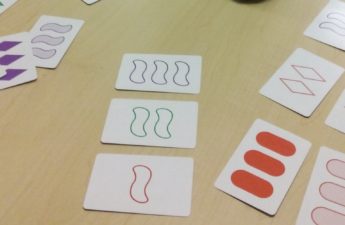Scene 1: In a typical first grade classroom.
Student: {staring at a broken pencil}
Teacher: Looks like your pencil is broken.
Student: {shifts stare to teacher}
Teacher: What do you think you should do?
Student: {continues to stare at teacher}
Early in my teaching career I had a class of first graders in a fairly large elementary school. I don’t recall the specific conversations, but I do remember having interactions with students that made me scratch my head and wonder if they had ever been taught to think. They might come upon some problem, usually minor from my perspective, and just stare at me as if I was the solution. Or maybe a student would tell me his problem and then shrug his shoulders or give an answer that didn’t make any sense at all when I asked what we could do about it.
I’m not only talking about problems in math class here. I’m talking about just any old problem that might show up during the course of a school day. A broken pencil, a torn paper, a missing lunchbox. Anything.
As green as I was at the time, and with my experiences as a successful student in traditionally run classrooms from PreK through college, I had the misguided notion that my job as a teacher was to fill student heads with the knowledge I had in mine. Things like how to read, write, spell, and do math appropriate to six and seven year olds. I was to introduce them to history and science facts and get them ready for their benchmark assessments. {Yes, the system I was in had their own standardized testing for first graders, even back in 1995!}
Remember when I said it didn’t seem like my students knew how to think? Well, that wasn’t just a characteristic of that first grade class. This was a pattern I noticed more and more no matter what age the students.
First graders. Third graders. Four year-olds. Fifth graders. First graders {again}. Middle graders. Four year-olds {again}. College students. Middle graders {again}.
Yes. You read that right. I have had college students who didn’t think for themselves. Who got stuck at the smallest of road blocks.
By the time I joined the ranks of middle school the first time, I had recognized the pattern and I had started shifting my view of the role of education. No longer did I view myself as an “expert” doling out information. My ideas of teaching were shifting toward facilitating learning. I began asking more questions to myself and to my students. Instead of asking them what the “next step” is in solving a math problem, I started the conversation by asking what they already understood and where they wanted to begin. Then I led them down the path they started, allowing them to navigate themselves to a potential solution.
I say “potential” solution because the paths we take sometimes don’t lead us where we want to go. We make mistakes. We change our thinking. We get lost. And in those places lie the best opportunities for learning.
Are you wondering where I am going with this? I promise this is the good part!
It may seem odd to you that children need to be taught how to think. I would argue that it’s not so much that they need to be “taught” to think, but rather that they need to be “allowed” to think. Even when their ideas don’t lead them in the right direction.
We all learn through exploring. We try something out and see how it goes. If it works we do it again. If it doesn’t work, we try something different or try to improve it somehow. So often, though, we take this knowledge we have gathered through our own experience as something everyone should know, even our children. We tell our children how to navigate their own problems, giving them solutions we have found to be successful. Sometimes our motivations are selfish, like when we just want something taken care of quickly. We don’t want them to “waste time” trying try a bunch of things that don’t work so we give them the “shortcut” we have discovered or created. Mostly, though, we are well intentioned. We are just trying to help our children be successful.
Here’s the thing, though. Getting straight to the shortcut robs our children of the opportunity to gain experience and can leave them looking to others for solutions. Yes, I admit sometimes we have to look to others for help. I certainly don’t know how to fix my washing machine or the transmission in my car, but giving our children the solution we want them to use up front doesn’t really help them in the long run. When we do, they develop the mindset that problems are solved the first time and can get discouraged when they aren’t immediately successful. {Ever seen a kid give up after the first try at something?} They also can develop the idea that there is only one right path to the solution.
This can stop a learner dead in his tracks.
Not knowing the “right” way is a major road block I see frequently, and it often prevents students from trying anything.
Want to know how to “teach” children to think for themselves? Want to help your child develop what those of us in education are calling Grit or Resilience these days?
Let. Them. Fail.
I know. Sounds pretty harsh, doesn’t it? It’s difficult for us to know the likely outcome for someone and let them do it anyway. Just like falling and getting back up was important as your child learned to walk, learning to make mistakes, recover, and try again is important in life. {And in learning math!}
So, here’s a challenge for you. The next time your child encounters a road block, stop yourself for a moment. Instead of rushing to give a solution, ask your child what he thinks he should do. Then allow him to try. If he fails, help him get back up, ask him what didn’t go well and what he thinks he should try next. Then encourage him to try again.
Rinse and repeat.
And, if you haven’t snagged this handy dandy guide to developing resilience, go check it out!
Have a problem solving story to share? I love hearing about your experiences, so leave them in the comments, okay?



